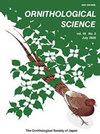鸟带记录揭示了新泻附近沿海森林中鸟类春秋迁徙时间的变化
IF 0.3
4区 生物学
Q4 ORNITHOLOGY
引用次数: 1
摘要
摘要基于27年的鸟类环带记录,分析了日本本州中部新泻市附近沿海森林中春季和秋季鸟类迁徙时间的变化。由于春季气温升高,所研究的一半鸟类,包括除居民外的所有迁徙类型,在春季到达或离开的时间明显提前。我们观察到,由于温度变化,春季迁徙时间的变化率与其他国家研究报告的变化率相同或略高。然而,由于尚不清楚的原因,水仙花捕蝇草和日本画眉鸟这两种夏季长途迁徙到附近山区的物种在春季的到来变得更早(提前)。秋季的中位捕获日期与五个物种的年份显著相关。其中,留鸟和流浪鸟日本白眼Zosterops japonicus和流浪鸟黑脸Bunting Emberiza spodocephala的捕获日期中位数每年都在上升,而日本知更鸟Luscinia akahige和其他两个物种(均为长途迁徙)的捕获日期则推迟了。我们假设,由于研究区域种群结构的变化,从简单的松林到亚冠层和灌木层发育良好的混合林的森林演替可能对日本白眼和黑面Bunting产生了强烈影响,导致秋季捕获日期的中位数提前。森林演替也可能影响了日本知更鸟的食物资源,使其能够在研究区停留更长时间,并导致秋季出发日期推迟。因此,春季和秋季鸟类迁徙时间的变化因环境因素的不同而不同。本文章由计算机程序翻译,如有差异,请以英文原文为准。
Bird-Banding Records Reveal Changes in Avian Spring and Autumn Migration Timing in a Coastal Forest Near Niigata
Abstract Changes in the timing of bird migration in spring and autumn in a coastal forest near the city of Niigata, central Honshu, Japan, were analyzed based on 27 years of bird-banding records. Half of the bird species studied, including all migratory types except residents, arrived or departed significantly earlier in spring due to an increase in spring temperatures. The rate of change we observed in spring migration timing due to changes in temperature was identical to or slightly greater than those reported in studies from other countries. The spring arrival of the Narcissus Flycatcher Ficedula narcissina and the Japanese Thrush Turdus cardis, both long-distance summer migrants to the nearby mountains, became earlier (advanced), however, for reasons that remained unclear. Median capture date in autumn was significantly associated with year for five species. Of these, the median capture date of the Japanese White-eye Zosterops japonicus, a resident and wandering bird, and the Black-faced Bunting Emberiza spodocephala, a wandering bird, advanced annually, while for the Japanese Robin Luscinia akahige and two other species (all long-distance migrants), it was delayed. We hypothesize that forest succession from a simple pine forest to a mixed forest with well-developed sub-canopy and shrub layers may have strongly influenced the Japanese White-eye and the Black-faced Bunting due to changes in population structure in the study area, resulting in an earlier median autumn capture date. Forest succession may also have influenced the Japanese Robin's food resources, enabling it to stay longer in the study area and resulting in a delay in autumn departure date. Thus, changes in bird migration timing differ according to different environmental factors in spring and autumn.
求助全文
通过发布文献求助,成功后即可免费获取论文全文。
去求助
来源期刊

Ornithological Science
ORNITHOLOGY-
CiteScore
1.20
自引率
0.00%
发文量
26
审稿时长
>12 weeks
期刊介绍:
Ornithological Science publishes reviews, original articles, short communications and comments covering all aspects of ornithology. Manuscripts are judged on the basis of their contribution of original data and ideas or interpretation. All articles are peer-reviewed by at least two researchers expert in the field of the submitted paper. Manuscript are edited where necessary for clarify and economy. Ornithological Science aims to publish as rapidly as is consistent with the requirements of peer-review and normal publishing constraints.
 求助内容:
求助内容: 应助结果提醒方式:
应助结果提醒方式:


